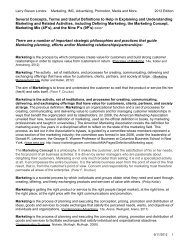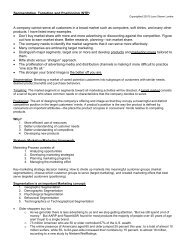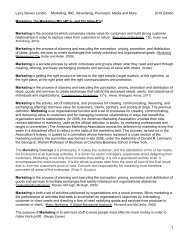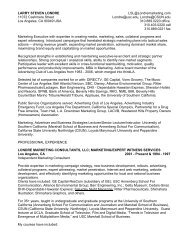Marketing, the Marketing Mix - Londre Marketing Consultants, LLC
Marketing, the Marketing Mix - Londre Marketing Consultants, LLC
Marketing, the Marketing Mix - Londre Marketing Consultants, LLC
You also want an ePaper? Increase the reach of your titles
YUMPU automatically turns print PDFs into web optimized ePapers that Google loves.
Larry Steven <strong>Londre</strong> <strong>Marketing</strong>, IMC, Advertising, Promotion, Media and More. 2010 Edition<br />
<strong>Marketing</strong>, <strong>the</strong> <strong>Marketing</strong> Concept, <strong>Marketing</strong> <strong>Mix</strong> (4P’s), and <strong>the</strong> Nine P’s (9P’s)©<br />
There are a number of important strategic philosophies and practices that guide a <strong>Marketing</strong><br />
effort and/or <strong>Marketing</strong> relationships:<br />
<strong>Marketing</strong> is <strong>the</strong> process by which companies create value for customers and build strong customer<br />
relationships in order to capture value from customers in return. (Principles of <strong>Marketing</strong>, 13E, Kotler and<br />
Armstrong, 2010)<br />
<strong>Marketing</strong> is <strong>the</strong> process of planning and executing <strong>the</strong> conception, pricing, promotion, and distribution<br />
of ideas, goods, services to create exchanges that satisfy individual and organizational goals. (<strong>Marketing</strong><br />
Management 13e, Kotler and Keller, 2009)<br />
"The aim of <strong>Marketing</strong> is to know and understand <strong>the</strong> customer so well that <strong>the</strong> product or service fits<br />
him (her/it) and sells itself." (Peter F. Drucker)<br />
<strong>Marketing</strong> is <strong>the</strong> activity, set of institutions, and processes for creating, communicating,<br />
delivering, and exchanging offerings that have value for customers, clients, partners, and society<br />
at large. The previous definition: <strong>Marketing</strong> is an organizational function and a set of processes for<br />
creating, communicating, and delivering value to customers and for managing customer relationships in<br />
ways that benefit <strong>the</strong> organization and its stakeholders. (In 2008, <strong>the</strong> American <strong>Marketing</strong> Association<br />
unveiled <strong>the</strong>ir new, revised definition of marketing, used as <strong>the</strong> official definition in books, by marketing<br />
professionals and taught in universities.) The American <strong>Marketing</strong> Association revisits <strong>the</strong> definition for<br />
marketing every five years in a disciplined effort to reflect on <strong>the</strong> state of <strong>the</strong> marketing field. This<br />
process, as laid out in <strong>the</strong> Association's bylaws, is guided by a committee whose members represent a<br />
cross-section of <strong>the</strong> marketing industry; <strong>the</strong> committee was formed in late 2006, under <strong>the</strong> leadership of<br />
Donald R. Lehmann, <strong>the</strong> George E. Warren Professor of Business at Columbia Business School in New<br />
York. (www.ama.org; http://www.marketingpower.com/AboutAMA/Pages/Definitionof<strong>Marketing</strong>.aspx)<br />
The <strong>Marketing</strong> Concept is a philosophy. It makes <strong>the</strong> customer, and <strong>the</strong> satisfaction of his or her needs,<br />
<strong>the</strong> focal point of all business activities. It is driven by senior managers, who are passionate about<br />
delighting <strong>the</strong>ir customers. <strong>Marketing</strong> is not only much broader than selling; it is not a specialized activity<br />
at all. It encompasses <strong>the</strong> entire business. It is <strong>the</strong> whole business seen from <strong>the</strong> point of view of <strong>the</strong> final<br />
result, that is, from <strong>the</strong> customer's point of view. Concern and responsibility for marketing must <strong>the</strong>refore<br />
permeate all areas of <strong>the</strong> enterprise. (Peter F. Drucker)<br />
<strong>Marketing</strong> is a societal process by which individuals and groups obtain what <strong>the</strong>y need and want through<br />
creating, offering, and freely exchanging products and services of value with o<strong>the</strong>rs. (Philip Kotler)<br />
<strong>Marketing</strong> is getting <strong>the</strong> right product or service to <strong>the</strong> right people (target market), at <strong>the</strong> right time, at<br />
<strong>the</strong> right place, at <strong>the</strong> right price with <strong>the</strong> right communications and promotion.<br />
<strong>Marketing</strong> is <strong>the</strong> process of planning and executing <strong>the</strong> conception, pricing, promotion and distribution of<br />
ideas, goods and services to create exchanges that satisfy <strong>the</strong> perceived needs, wants, and objectives of<br />
individuals and organizations. (Contemporary Advertising, 13 th e, Arens, Weingold, Arens, 2011)<br />
1
Larry Steven <strong>Londre</strong> <strong>Marketing</strong>, IMC, Advertising, Promotion, Media and More. 2010 Edition<br />
<strong>Marketing</strong> is <strong>the</strong> process of planning and executing <strong>the</strong> conception, pricing, promotion and distribution of<br />
goods and services to facilitate exchanges that satisfy individual and organizational objectives.<br />
(Understanding Business, Nickels, McHugh, McHugh, 2008)<br />
<strong>Marketing</strong> is both a set of activities performed by organizations and a social process. Micro-marketing is<br />
<strong>the</strong> performance of activities that seek to accomplish an organization’s objectives by anticipating<br />
customer or client needs and directing a flow of need satisfying goods and services from producer to<br />
customer or client. (Basic <strong>Marketing</strong>, A Global-Managerial Approach, Perreault and McCarthy, 2005)<br />
<strong>Marketing</strong> is <strong>the</strong> process of creating, distributing, promoting and pricing goods, services, and ideas to<br />
facilitate satisfying exchange relationships with consumers and to develop and maintain favorable<br />
relationships with shareholders in a dynamic environment. (Foundations of <strong>Marketing</strong>, Third Edition, Pride<br />
and Ferrel, 2009)<br />
The purpose of <strong>Marketing</strong> is to sell more stuff to more people more often for more money in order to<br />
make more profit. (Sergio Zyman)<br />
<strong>Marketing</strong> <strong>Mix</strong> is <strong>the</strong> combination of four elements, called <strong>the</strong> 4P’s (Product, Price, Promotion and<br />
Place), that every company has <strong>the</strong> option of adding, subtracting, or modifying in order to create a<br />
desired marketing strategy. (Philip Kotler)<br />
The <strong>Marketing</strong> <strong>Mix</strong> is <strong>the</strong> set of controllable tactical marketing tools--Product, Price, Promotion and<br />
Place--that <strong>the</strong> firm blends to produce <strong>the</strong> response it wants in <strong>the</strong> target market. (Principles of <strong>Marketing</strong>,<br />
13E, Kotler and Armstrong, 2010)<br />
Consumer/Business-to- Business/Nonprofit/Internal <strong>Marketing</strong><br />
Consumer <strong>Marketing</strong> occurs when organizations sell to individuals or households that buy, consume,<br />
and dispose of products.<br />
Business-to-Business <strong>Marketing</strong> occurs when a business purchases goods or services to produce<br />
o<strong>the</strong>r goods, to support daily operations, or to resell at a profit.<br />
Nonprofit <strong>Marketing</strong> occurs when an organization does not try to make a profit but instead attempts to<br />
influence o<strong>the</strong>rs to support its cause by using its service or by making a contribution.<br />
Internal <strong>Marketing</strong> occurs when managers of one functional unit market <strong>the</strong>ir capabilities to o<strong>the</strong>r units<br />
within <strong>the</strong>ir own organization. (<strong>Marketing</strong>, Connecting with Customers, Harrrell, 8e, 2008)<br />
Nine P’s (9 P’s)<br />
(I own a copyright for this concept, <strong>the</strong> Nine P’s/9 P's, which augments <strong>the</strong> <strong>Marketing</strong> <strong>Mix</strong> and<br />
4P’s by <strong>the</strong> American <strong>Marketing</strong> Association, Neil Borden and Jerome McCarthy):<br />
1. Planning or <strong>Marketing</strong> Process: To develop and transform marketing objectives to marketing<br />
strategies to tactics, marketing management must make basic decisions on marketing targets,<br />
marketing mix, marketing budgets/expenditures and marketing allocations. Dividing <strong>the</strong> total<br />
2
Larry Steven <strong>Londre</strong> <strong>Marketing</strong>, IMC, Advertising, Promotion, Media and More. 2010 Edition<br />
marketing budget among <strong>the</strong> various tools in <strong>the</strong> marketing mix and for <strong>the</strong> various products,<br />
channels, promotion, media and sales areas.<br />
2. People/Prospects (Target Market)<br />
• Target Market consists of a set of buyers who share common needs or characteristics that<br />
<strong>the</strong> company decides to serve. Market targeting can be carried out at several different<br />
levels.<br />
• A product focusing on a specific target market contrasts sharply with one following <strong>the</strong><br />
marketing strategy of mass marketing.<br />
• Defining a target market requires market segmentation, <strong>the</strong> process of segmenting <strong>the</strong><br />
entire market as a whole and separating it into manageable units based on demographics,<br />
geographics, psychographics, behavior, technographics or technographical<br />
characteristics.<br />
• Segmentation is an important <strong>Marketing</strong> concept; <strong>the</strong> market segmentation process<br />
includes:<br />
• Determining <strong>the</strong> characteristics of segments (using Geographic, Demographic,<br />
Psychological, Behavioral and/or Technographics or Technographical<br />
Segmentation in <strong>the</strong> target market(s).<br />
• Separating and targeting <strong>the</strong>se segments in <strong>the</strong> market based on those<br />
characteristics.<br />
• Checking to see whe<strong>the</strong>r any of <strong>the</strong>se market segments are large enough to<br />
support <strong>the</strong> organization's product.<br />
• Once a target market is chosen, <strong>the</strong> organization can develop its marketing<br />
strategies to target this market.<br />
3. Product: The goods and service combination <strong>the</strong> firm offers to <strong>the</strong> target market, including variety<br />
of product mix, features, designs, packaging, sizes, services, warrantees and return policies.<br />
• A product is anything that can be offered to a market for attention, acquisition, use or<br />
consumption that might satisfy a want or need. (Kotler)<br />
• A service is any activity or benefit that one party can offer to ano<strong>the</strong>r that is essentially<br />
intangible and does not result in <strong>the</strong> ownership of anything. (Kotler)<br />
• “Product” includes packaging, as a subset of <strong>the</strong> total offering. Brand managers use<br />
packaging as a badge, enhancing <strong>the</strong> product’s value. Here’s an example: In fall 2008,<br />
McDonald's scrapped and changed its package design across 118 countries, 56<br />
languages. Packaging can increase <strong>the</strong> perceptions about <strong>the</strong> quality of <strong>the</strong> product.<br />
• A Product or service also should have Purpose, which is discovering <strong>the</strong> product’s real<br />
value, use, difference, reason, or function for <strong>the</strong> consumer and user.<br />
4. Price: All aspects regarding pricing. The price consumers are willing to pay. Retail<br />
price/wholesale, discounts, trade-in allowances, quantity discounts, credit terms, sales and<br />
payment periods.<br />
5. Place/Distribution: The company’s activities that make <strong>the</strong> product available, using distribution<br />
and trade channels, coverage, assortments, locations, inventory and transportation<br />
characteristics and alternatives. Typical supply chain consists of four links in <strong>the</strong> chain:<br />
Producer/Factory/Manufacturer, Distributor, Wholesaler, Retailer supplying <strong>the</strong> consumer and<br />
user.<br />
3
Larry Steven <strong>Londre</strong> <strong>Marketing</strong>, IMC, Advertising, Promotion, Media and More. 2010 Edition<br />
6. Promotion: The communication element includes personal and non-personal communication<br />
activities. Activities that communicate <strong>the</strong> merits of <strong>the</strong> overall product, which includes:<br />
• Personal Selling/ Sales Force<br />
• Advertising--Mass or nonpersonal selling: TV, radio, magazines, newspaper, outdoor/outof-home.<br />
Advertising is structured and composed non personal communication of information,<br />
usually paid for and usually persuasive in nature, about products (goods, services) and<br />
ideas by identified sponsors through various media. (Contemporary Advertising, 13 th e, Arens,<br />
Weingold, Arens, 2011)<br />
Advertising is any paid form of nonpersonal presentation and promotion of ideas, goods,<br />
or services by an identified sponsor. (Principles of <strong>Marketing</strong>, 13E, Kotler and Armstrong,<br />
2010). Ads can be a cost-effective way to disseminate messages, whe<strong>the</strong>r to build a brand<br />
preference or to educate people.<br />
• Sales Promotion--Trade deals, samples, coupons, premiums, tie-ins, p-o-p, displays,<br />
sweepstakes, allowances, trade shows, sales rep contests, events/experiences and more.<br />
• Collateral Materials--Booklets, catalogs, brochures, films, sales kits, promotional products<br />
and annual reports.<br />
• Direct <strong>Marketing</strong> (also referred to as Action or Direct Response Advertising)--online, direct<br />
mail, database management, catalogs, telemarketing, and direct-response ads. Includes<br />
Interactive/Internet/web<br />
• Events and Experiences<br />
• Public Relations--press releases, publicity. Securing editorial space, as opposed to paid<br />
space--usually in print, electronic or Internet media. Promote or “hype” a product, service,<br />
idea, place, person or organization, internal communication, lobbying. PR involves a<br />
variety of programs designed to promote or protect a company’s image/reputation or<br />
individual products.<br />
7. Partners: Marketers can’t create customer value and build customer relationships by <strong>the</strong>mselves.<br />
They work closely with o<strong>the</strong>r company departments (inside partners) and often with partners<br />
outside <strong>the</strong> firm. Changes are occurring in how marketers connect with <strong>the</strong>ir suppliers, channel<br />
partners and o<strong>the</strong>rs. A joint partnership; <strong>the</strong> joint relationships, partnerships and alliances.<br />
The legal relationship existing between two parties; a relationship resembling a legal partnership<br />
and usually involving close cooperation between parties having specific and joint rights and<br />
responsibilities as a common enterprise. One of <strong>the</strong> heavy timbers that streng<strong>the</strong>n a ship’s deck<br />
to support a mast. Usually plural or “Partners,” not Partner.<br />
From Philip Kotler: Value chains, of suppliers, distributors and customers. Partnering with specific<br />
suppliers or distributors create a value-delivery network; also called a supply chain. Partnership<br />
<strong>Marketing</strong>; Partner Relationship Management.<br />
8. Presentation: The acts of presenting any of <strong>the</strong> 9P’s© to your customers, suppliers, wholesalers,<br />
retailers, sales force, marketing intermediaries, clients, and/or partners. A symbol or image that<br />
represents something; a descriptive or persuasive account (as a sales person of his product).<br />
Something set forth for <strong>the</strong> attention of mind.<br />
9. Passion: Intense, driving or overmastering feelings, emotions in <strong>the</strong> marketing and selling of<br />
products or services. Emotional, as distinguished from reason and rational decision-making; A<br />
strong liking for or devotion to some activity; Deep interest in your partnership/presentation of any<br />
of <strong>the</strong> 9P’s© to any target or partner.<br />
4
Larry Steven <strong>Londre</strong> <strong>Marketing</strong>, IMC, Advertising, Promotion, Media and More. 2010 Edition<br />
Advertising is structured and composed nonpersonal communication of information, usually paid for and<br />
usually persuasive in nature, about products (goods, services) and ideas by identified sponsors through<br />
various media. (Contemporary Advertising, 13 th e, Arens, Weingold, Arens, 2011)<br />
Advertising consists of paid notices from identified sponsors normally delivered through communication<br />
media. (Kleppner’s Advertising Procedure, Lane, King, Reichert, 18 th Edition, 2011)<br />
Brand is a name, term, sign, symbol, design, or a combination of <strong>the</strong>se that identifies <strong>the</strong> products or<br />
services of one seller or group of sellers and differentiates <strong>the</strong>m from those of competitors. (Principles of<br />
<strong>Marketing</strong>, 13e, Kotler and Armstrong, 2010)<br />
Branding is a marketing function that identifies products (goods and services) and <strong>the</strong>ir source, and<br />
differentiates <strong>the</strong>m from all o<strong>the</strong>r products. (Contemporary Advertising, 13 th e, Arens, Weingold, Arens, 2011)<br />
Integrated <strong>Marketing</strong> is when all departments of a firm work toge<strong>the</strong>r to serve <strong>the</strong> needs of <strong>the</strong><br />
customer.<br />
Integrated <strong>Marketing</strong> Communications (IMC)<br />
As defined by <strong>the</strong> American Association of Advertising Agencies, Integrated <strong>Marketing</strong><br />
Communications is a concept of marketing communications planning that recognizes <strong>the</strong> added value<br />
of a comprehensive plan. Such a plan evaluates <strong>the</strong> strategic roles of a variety of communications<br />
disciples--for example, general advertising, direct response, sales promotion and public relations--and<br />
combines <strong>the</strong>se disciplines to provide clarity, consistency and maximum impact through <strong>the</strong> seamless<br />
integration of messages. IMC is <strong>the</strong> process of using promotional tools in a unified way so that a<br />
synergistic communications effect is created. (<strong>Marketing</strong> Management 13e, Kotler and Keller, 2009)<br />
Media Planning is <strong>the</strong> series of decisions involved in <strong>the</strong> delivery of an advertising message to<br />
prospective purchasers and/or users of a product or service. (Belch and Belch)<br />
Promotion is <strong>the</strong> coordination of all seller-initiated efforts to set-up channels of information and<br />
persuasion to sell goods and services or to promote an idea. (Belch and Belch)<br />
Promotional <strong>Mix</strong> includes advertising, sales promotion, public relation/ publicity, personal selling, plus<br />
direct marketing and Internet/interactive media. Direct marketing is direct mail, mail order catalogs,<br />
database marketing, direct selling, telemarketing, and direct response ads through direct mail, <strong>the</strong><br />
Internet, and various media. (Belch and Belch)<br />
Product Placement advertisements are promotional ads placed by marketers or <strong>the</strong>ir agencies using<br />
real commercial products and services in media, where <strong>the</strong> presence of a particular brand is <strong>the</strong> result of<br />
an economic exchange. When featuring a product is not part of an economic exchange, it is called a<br />
product plug. Product Placement appears in plays, film, television shows and series, music videos, video<br />
games and books. Product placement occurs with <strong>the</strong> inclusion of a brand's logo in <strong>the</strong> show or shot, or<br />
a favorable mention or appearance of a product. This is done without disclosure, and under <strong>the</strong> premise<br />
that it is a natural part of <strong>the</strong> work. Most major movie releases today contain product placements. The<br />
most common form is in movie and television placements and more recently computer and video games.<br />
Push Strategy involves <strong>the</strong> manufacturer using <strong>the</strong> sales force and trade promotional tools and money<br />
to induce intermediaries to carry, promote and sell <strong>the</strong> product to end users.<br />
Pull Strategy involves <strong>the</strong> manufacturer using advertising and sales promotion tools to persuade<br />
consumers to ask intermediaries for <strong>the</strong> product, thus inducing <strong>the</strong> intermediaries to order and stock <strong>the</strong><br />
product or products.<br />
5
Larry Steven <strong>Londre</strong> <strong>Marketing</strong>, IMC, Advertising, Promotion, Media and More. 2010 Edition<br />
U.S.P. (Unique Selling Proposition): Many marketers feel that companies should aggressively promote<br />
specific product or service benefits, and, in <strong>the</strong> use and strategy of U.S.P. one benefit which is a strong,<br />
competitive advantage. Using that benefit or benefits to build <strong>the</strong>ir positioning strategy. The company<br />
decides how many differences or differentials to promote and to whom. The Unique Selling Proposition<br />
(also Unique Selling Point) is a marketing concept that was first proposed as a <strong>the</strong>ory to explain a pattern<br />
among successful advertising campaigns of <strong>the</strong> early 1940s. It stated that such campaigns made unique<br />
propositions to <strong>the</strong> customer and that this convinced <strong>the</strong>m to switch brands. The term was invented by<br />
Rosser Reeves of Ted Bates & Company. Today <strong>the</strong> term is used in o<strong>the</strong>r fields or just casually to refer<br />
to any aspect of an object that differentiates it from similar objects.<br />
Businesses and corporations use USPs as a basis for <strong>the</strong>ir marketing and advertising campaigns.<br />
Larry Steven <strong>Londre</strong><br />
<strong>Londre</strong> <strong>Marketing</strong> <strong>Consultants</strong>, <strong>LLC</strong> / USC / CSUN<br />
11072 Cashmere Street, Los Angeles, CA 90049<br />
310.889.0220<br />
310.889.0221 fax<br />
www.<strong>Londre</strong><strong>Marketing</strong>.com<br />
LSL@<strong>Londre</strong>marketing.com, <strong>Londre</strong>@usc.edu, <strong>Londre</strong>@csun.edu<br />
©Larry Steven <strong>Londre</strong>, <strong>Londre</strong> <strong>Marketing</strong> <strong>Consultants</strong>, <strong>LLC</strong> 2010<br />
6










